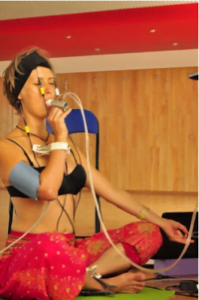The next line of Yoga Sutras does not involve any difficulty for translation, as well as for commentary and understanding.
प्रच्छर्दनविधारणाभ्यां वा प्राणस्य ॥ ३४॥
1.34 pracchardana-vidhāraṇābhyām vā prāṇasya
pracchardana (n.) – a well-known word that in terms of literature on yoga denotes “exhalation”. It consists of the prefix pra + cchardana – a noun produced from the root chṛd – “to eject”, “to outthrow”.
vidhāraṇābhyāṃ (m. instr. du.) – “holding”, “retention”, “control”; the prefix vi (‘out of, from’) + dhāraṇā “holding”, from the root dhṛ – “to hold/retain”, that we already know.
vā (ind.) – “or”.
prāṇasya (m. gen. sg.) – “prana” or “air”.
Thus in consideration of the context the sutra shall go as follows:
1.34 Or [for withstanding scattering of mind (chitta vikshepa)] inhalation and control (holding) of air (prana).
It is quite obvious that Patanjali refers to pranayama as a means of assembling-stabilizing one’s mind. This idea shall be further on developed in the second section of the work. Being short, the sutra makes it impossible for us to understand what was that specific technique meant by the author – whether it is an inspiratory hold, or a slow exhalation with air control, or something else, especially that there is a variety of similar pranayamas described in later texts on yoga. Yet the main point here is that Patanjali has clearly determined the essence and the objective of pranayamas that are often omitted in terms of modern fitness-“yoga”. Pranayamas are intended for working with one’s mind and do not come as another form of physical exertion. The expansion in their number occurred in medieval texts may be preconditioned by increase of psychological states they wanted to induce. After all, every system tends to complication and progress of sophistication.
On the other hand, none of yoga treatise that I know describes precise principles of linking the types of breathing and the states thus formed. These are the discoveries of modern body-oriented psychotherapy that may serve as methodology for revealing these principles. Curiously enough, but notwithstanding the fact that western body-oriented therapists have empirically rediscovered the rule that “the more shallow the breath, the more problems the person has”, the first attempt to put this together, to examine pranayama from this very perspective belongs (I can’t but praise myself for it) to the author of these lines. And it was for the first time described in the book “Chakra Psycho-Diagnostics”, and later on – in “Yoga: Physiology, Psychosomatic, Bioenergetics”.
Later on the concept based upon empiric observations was from different perspectives verified by the founder of national [Ukrainian – translator’s note] Yoga-therapy – Elena Akhramieieva. The result of spirometer tests showed, in particular (within the context of this article), that there is a link between the place of failure in smooth full yogic breath and the type of problematic reminiscences. In other (slang) words: one’s breathing is poor at the level of the chakra that has a “tail” in it.
Counter meterage – gauging of state of consciousness under the influence of pranayamas – would be impossible in the scope of scientific method since state of consciousness is not subject to objectification; thus here we, just like the yogi of ancient times, shall remain empiricists and rely upon our experience that in complete alignment with Patanjali tells: when breathing becomes even, consciousness shall become more aggregated.
Those who want to read the articles on the topic can do it here. In particular I would like to single out the article Pranayama as Meditation.

